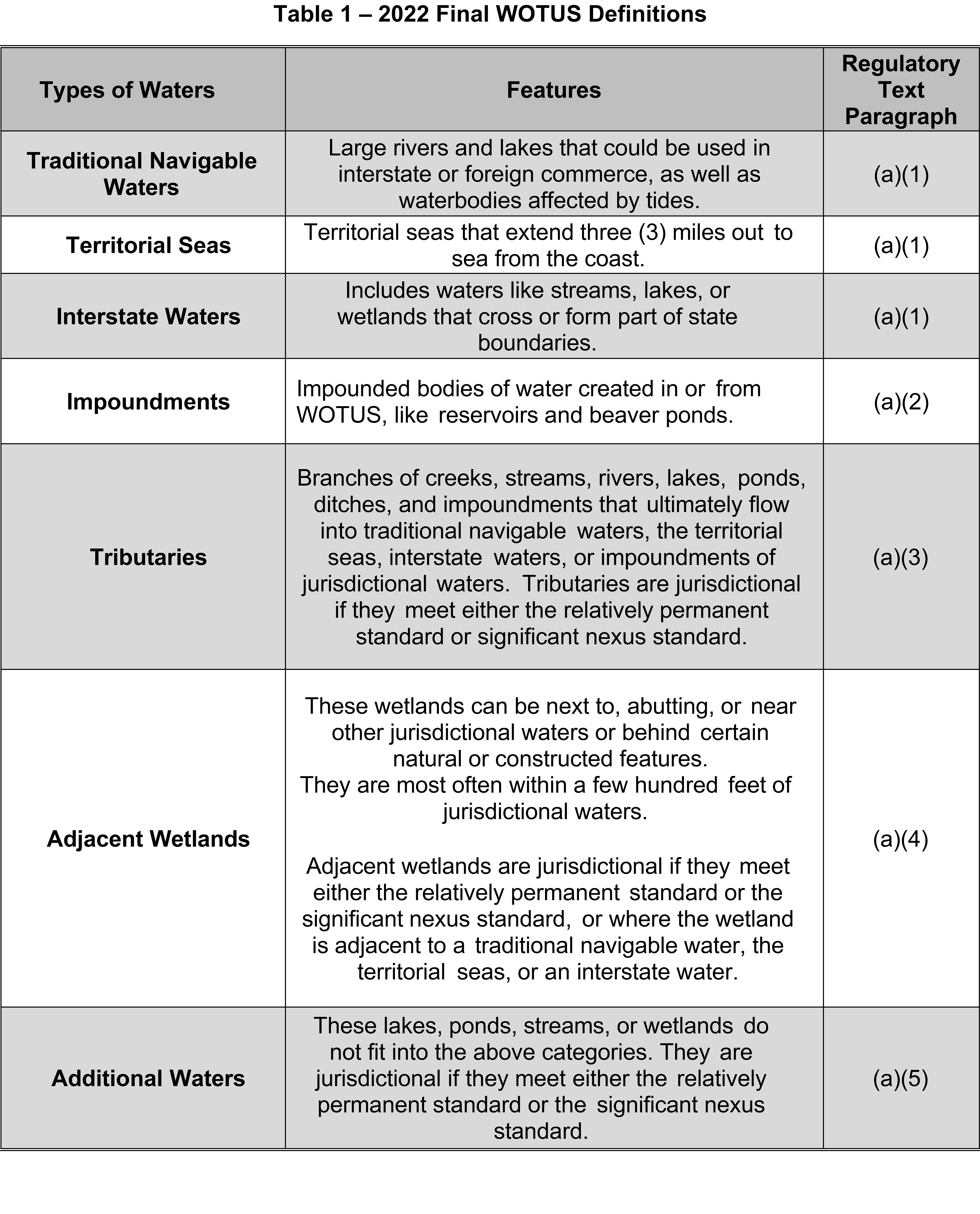In the 2022 Final WOTUS Rule, the US EPA and USACE provide some additional guidance and definitions for relatively permanent waters, adjacent wetlands, and significant nexus. The relatively permanent waters definition will typically affect paragraph (a)(3) waters, to meet the standard “the waterbodies must be relatively permanent, standing, or continuously flowing waters connected to paragraph (a)(1) waters or waters with a continuous surface connection to such relatively permanent waters or to paragraph (a)(1) waters[1].” The 2022 Rule also continues to use the term significant nexus. The current guidance on significant nexus is “a test that clarifies if certain waterbodies, such as tributaries and wetlands, are subject to the Clean Water Act based on their connection to and effect on larger downstream waters that Congress fundamentally sought to protect. A significant nexus exists if the waterbody (alone or in combination) significantly affects the chemical, physical, or biological integrity of traditional navigable waters, the territorial seas, or interstate waters[2]”.
Field Implementation
Implementing the final 2022 Rule for (a)(1) waters such as territorial seas, interstate waters, and Traditional Navigable Waters (“TNW”) in the field will be fairly standard. Practitioners will continue to use USACE guidance on the Ordinary High Water Mark (“OHWM”) and tide markers to define jurisdictional boundaries. The question for (a)(1) waters will not be if they are jurisdictional, but where the jurisdictional boundary lies.
In the case of (a)(3), (a)(4), and (a)(5) waters, specialists will continue to use USACE guidance such as the 1987 delineation manual, Regional Supplements, and OHWM guidance; however, jurisdiction may not be clear cut. While it has been the standard that the USACE is the regulating authority to determine jurisdiction, there has been a continued push by industry for clear definitions that allow individuals to have an indication of a project’s jurisdiction prior to submitting documentation to the USACE. This clarity gives those working in waters a better understanding of when permits are required. An experienced specialist will be able to provide guidance on the likely jurisdiction of a water but that can still leave room for interpretation of jurisdiction by the USACE. This will be especially true in arid areas and specifically with intermittent streams, ditches carrying stream flows, and wetlands adjacent to streams or floodplains.
Conclusion
While the 2022 Final WOTUS Rule does provide some additional guidance on relatively permanent waters and adjacent wetlands, there is still room for interpretation with regard to significant nexus and relatively permanent water. The 2022 Rule will not go into effect until March 20, 2023. There is discussion that the USACE will be providing additional regional guidance on the finalized rule to help interpret significant nexus and provide clarity around tributaries that can often raise questions when determining if a wetland or water is a WOTUS.
The new rule will continue to have exclusions from WOTUS. These exclusions include but are not limited to prior converted cropland, water treatment systems, artificially irrigated areas, artificial lakes or ponds, waterfilled depressions, swales and erosional features, and ditches. It should be noted that some of these waters can still be considered WOTUS (such as ditches) if they are considered relatively permanent and carry (a)(3) tributaries. Ditches by and large are excluded if they are roadside diches that are excavated wholly in and draining only dry land, and that do not carry relatively permanent flow of water.
It should be noted that only the USACE has the final and/or legal authority to confirm the presence and boundaries of WOTUS. Spirit Environmental, LLC (“Spirit”), along with other industry professionals, will use the guidance provided by the USACE and US EPA to provide our best professional judgement on why we believe a wetland or waters would be considered a WOTUS and therefore jurisdictional. This judgement is only a recommendation and should be confirmed with the USACE if a project will impact an aquatic feature.
Until the 2022 Final WOTUS Rule becomes effective, the USACE will continue to use the pre‑2015 guidance. It is Spirit’s belief that few industries will see a change in project impacts and need for USACE Section 404 permits with the implementation of the 2022 Final WOTUS Rule. This is based in the fact that the 2022 Final WOTUS Rule is built off the current practices which follow the pre-2015 guidance. The establishment of regional guidance will help provide additional clarity on how the 2022 Final WOTUS Rule will impact different regions; however, it will likely be some time before this guidance is available. Until that time, please continue to reach out to Spirit, maintain dialogue with the USACE prior to impacting aquatic features, and when in doubt request a Section 404 permit (or other applicable permit) for any activities impacting aquatic features.
Spirit is available to complete environmental desktop reviews if clients want to determine the likelihood of WOTUS features within their project area. Spirit can provide additional follow up with a formal Wetland and Waterbody Delineation if potential WOTUS features are identified.
[1] US EPA and US Army Corps of Engineers.
[2] US EPA and US Army Corps of Engineers.



